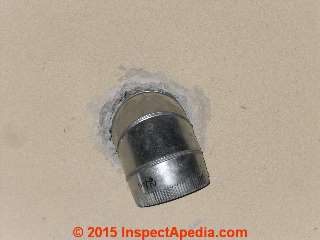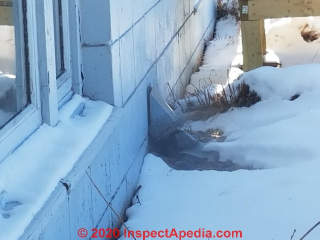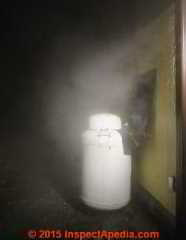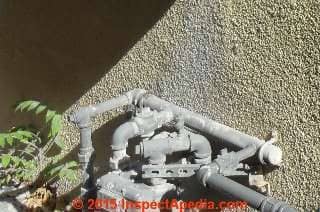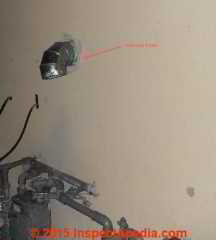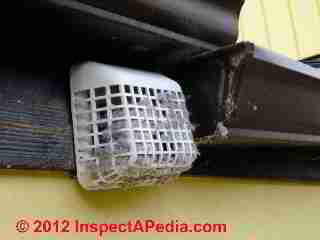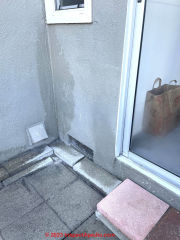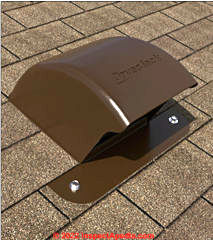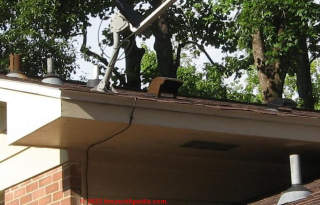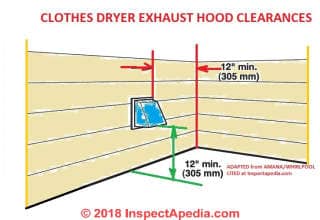 Clothes Dryer Exhaust Vent Termination Clearances
Clothes Dryer Exhaust Vent Termination Clearances
- POST a QUESTION or COMMENT about clothes dryer exhaust venting, ducting installation procedures, codes, standards
Clothes dryer exhaust vent clearance distances & specifications:
Dryer vent distance to gas meter, air conditioners, other building features. How far should the dryer vent exhaust opening be from various building features?
What safety hazards are caused if the dryer vent blows lint on to a gas meter regulator or onto an oil burner?
These conditions are unsafe, risking fire or explosion or loss of heat.
Page top photo: a clothes dryer vent located just inches from an air conditioner compressor/condenser unit air intake screen risks clogging the condensing coil, causing A/C operating problems or even damage.
This article series describes good practices for clothes dryer vent installation, lint traps, wall vents, filters, and screens.
We include a list of clothes dryer fire safety hazards and other clothes dryer installation or maintenance mistakes that are either unsafe or that interfere with effective, economical dryer operation. We discuss types of dryer vent ducting and dryer vent doors or opening protection devices
InspectAPedia tolerates no conflicts of interest. We have no relationship with advertisers, products, or services discussed at this website.
Clothes Dryer Vent Termination Clearance Distances
 Typical Clothes Dryer Exhaust Vent Termination Clearance Distances & Codes
Typical Clothes Dryer Exhaust Vent Termination Clearance Distances & Codes
Above: Amana / Whirlpool clothes dryer installation manuals typically include the clearance requirements for the exterior wall dryer exhaust vent hood or "exhaust hood" including
- An exhaust hood should cap the vent to keep rodents and insects from entering the home.
- Do not use an exhaust hood with a magnetic latch.
- Locate the vent such that there is no less than 12" (305mm) between the bottom of the exhaust vent hood and the ground surface
- Locate the vent such that there is no less than 12" (305mm) between the nearest side of a dryer exhaust vent hood and an adjoining wall or building inside corner
- No obstructions by snow, flowers, rocks, plants, fences, walls, air conditioner condenser/compressor units, etc.
- Install exhaust hood and use caulking compound to seal exterior wall opening around exhaust hood
- Vent must fit over the exhaust hood. Secure vent to exhaust
hood with 4" (102 mm) clamp. Run vent to dryer location
using straightest path possible.
Avoid 90° turns. Use clamps to seal all joints.
Do not use duct tape, screws, or other fastening devices that extend into interior of vent to secure vent, because they can catch lint. - (Amana 2017)
Common Clothes Dryer Vent Termination Clearance Distance Questions & Answers
- DRYER VENT TERMINATION DISTANCE to AIR CONDITIONER / HEAT PUMP / AIR INTAKE
- DRYER VENT TERMINATION DISTANCE to CEILING
- DRYER VENT TERMINATION CLEARANCE to COMBUSTIBLES
- DRYER VENT TERMINATION COVER, SCREEN, BIRDS, RODENTS
- DRYER VENT TERMINATION DISTANCE to GAS METER or REGULATOR
- DRYER VENT TERMINATION DISTANCE to GROUND
- DRYER VENT TERMINATION DISTANCE to DOORS or WINDOWS
- DRYER VENTING CLEARANCES in INTERIOR WALLS & CEILINGS
- DRYER VENT TERMINATION to WATER HEATER, OIL BURNER, GAS BURNER
Dryer vent clearance to Air Conditioner, Heat Pump, motors, heating equipment, air intakes
Question: distance from dryer vent to A/C or heat pump condenser unit
(May 10, 2015) Ryan said:
Is there any minimum distance standard that a dryer vent should terminate away from a A/C condenser? My neighbors dryer vent terminates about a foot away from his condenser.
It seems to me that this could allow lint to blow all over the fins of the condenser reducing efficiency and possibly shorten the life of the condenser. Any idea? Thanks.
Reply:
Ryan
Clearance distances for air conditioners are given
I haven't found a code citation specifically addressing clothes dryer clearance to AC unit condensers but that topic is discussed in the article I cite above.
I agree that regardless of distance, if lint is clogging the condenser fins that's going to be a problem. There also *might* be a problem from hot air exiting close to the condenser too.
Reader Question: 2016/03/24 Stephanie said:
What is the required distance between a through the outside wall direct furnace vent and a dryer vent.
I'm renting and they are very close together. I tried to find the requirements myself but was unsuccessful.
Thank you so much
This question appeared originally
at INDOOR AIR QUALITY IMPROVEMENT GUIDE
Reply:
Stephanie: if the direct vent furnace air intake can pull in lint from the clothes dryer the installation is unsafe.
Lint clogging the direct-vented furnace could result in vent overheating and possibly a building fire. But that's a subjective opinion on my part as I have not seen an explicit clearance distance stated in model building codes nor installation instructions.
at DIRECT VENTS / SIDE WALL VENTS we find a more general clearance specifications that in my view serve as a reasonable model-answer to your question. I quote:
- The exhaust vent terminal shall be located at least 3-feet above any forced air inlet located within 10-feet.
See [the figure in the original article cited above] for a depiction [courtesy of Thermo Pride] of the minimum required clearances between vent terminations and building features according to the National Fuel Gas Code (NFGC).[19]
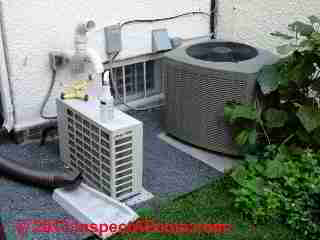 This article and thus my suggested specification (10 feet) recognizes that dryer lint can clog a key vent such as on a gas regulator at a distance of 4 feet nd that a significantly greater distance would be needed for safe clearance between a clothes dryer vent outlet and the air inlet of any mechanical system such as a direct vent chimney sidewall or rooftop penetration.
This article and thus my suggested specification (10 feet) recognizes that dryer lint can clog a key vent such as on a gas regulator at a distance of 4 feet nd that a significantly greater distance would be needed for safe clearance between a clothes dryer vent outlet and the air inlet of any mechanical system such as a direct vent chimney sidewall or rooftop penetration.
That's a reasonable minimum distance of 10 feet.
The local building code official is the final authority on questions like this, particularly as there may be site conditions that for safety should change general safe clearance distance recommendations
at A/C CLEARANCES from OTHER MECHANICALS
where we discuss distances from a dryer vent to an air conditioner compressor, we include the following:
In our photo above, from a Minneapolis MN home, these two compressor/condenser units are just about three feet apart - a little close, and that right-most larger compressor/condenser unit is too close to building walls, a clothes dryer vent, and shrubbery.
We also see that direct-vented heating appliance white PVC piping is blowing exhaust close to these units. The installation is nice-looking and neat though.
- Clothes dryer vent outlet: Do not locate a compressor/condenser unit where the clothes dryer vent will blow onto or close to the unit.
Lint-clogging of the compressor/condenser's condensing coils is likely to be a problem and the extra warm air won't help the cooling cycle efficiency or equipment life. Move the equipment or move the dryer vent. - Heating appliance direct vent outlet: Do not locate the outdoor HVAC compressor/condenser unit where exhaust from a direct-vented heating appliance will blow onto the unit.
Dryer Vent Termination to Ceiling
Question: how far a wall mounted dryer should be from the ceiling
(Dec 28, 2015) Anonymous said:
Is there a law/guideline how far a wall mounted dryer should be from the ceiling
Reply:
Anon:
Check the installation instructions for your clothes dryer - the manufacturer will give the necessary clearance distances.
Common sense will also tell us that the dryer opening and controls have to be readily accessible by a user standing on the floor.
Dryer Vent Termination Needs a Cover: Keep out Drafts, Rodents, Birds, Mice
Dryer vent termination hoods should have a self-closing flapper or door to prevent back-drafting of cold air into the building.
This door or flapper, properly maintained, also helps keep mice, birds, insects or other pests out of the dryer vent - a potential cause of fires as well as an interference that increases clothes drying time and cost.
An InspectApedia.com reader provided photographs of a clothes dryer exhaust vent termination on the building's exterior wall.
Above we see that there is no proper cover on this dryer vent: birds, rodents, or someone else can enter the dryer vent, nest therein, block up the dryer vent, and cause a dryer fire or a building fire.
See details
at CLOTHES DRYER VENT TERMINATION & SCREENS
At DRYER VENT DISTANCE to GAS METERS we see more trouble with this ugly dryer vent installation:
Minimum Fire Clearance distance from clothes dryer vent to foam insulation products
Reader Question: 2017/06/03 Ron said:
is steel dryer vent OK to use against polystyrene insulation
Reply: take a look at clothes dryer operating temperatures, foam insulation ignition point, and the effects of thermophoresis
Ron, I haven't found a model building code citation specifically regarding dryer vent clearance from foam insulation products and I don't think there is one.
A short answer offered by some plumbing experts is that as long as you are meeting other dryer vent code requirements such as length restrictions your system should be accepted by your local code officials.
Clothes dryers used in residential settings normally operate between about 125°F to 135°F. The maximum operating temperature of a clothes dryer under varying conditions might be perhaps 176°F.
Thermophoresis, a chemical change that lowers the ignition point of many building materials, is unlikely to occur below about 200°F.
Dryer outlet temperature will also vary depending on local conditions such as the temperature of air entering the clothes dryer.
These are in-dryer temperatures or temperatures measured at the dryer vent outlet. The temperatures inside the dryer heating element may be much higher.
Details are at CLOTHES DRYER TEMPERATURES
Watch out: however some combustible foam or other building products close to or in contact with a clothes dryer vent might increase the risk of a building fire in abnormal conditions such as an abnormally-hot dryer vent caused by other problems (lint clogging, for example).
A clothes dryer with a lint-clogged lint trap or exhaust can reach temperatures over 750°F, or 400°C. That's plenty hot enough to lead to ignition of some materials.
The ignition point of polystyrene insulation, defined as the "transfer ignition temperature" is around 680°F or 360°C.[California Fire Marshall & EUMEPS] That's below the temperature given above for a lint-clogged clothes dryer.
Fire Safety and EPS and Dryer Vents: OPINION: So even if it is enclosed within a building wall or ceiling cavity, where it might be in contact with a clothes dryer vent it would be smart to cover your polystyrene insulation with a layer of fire-resistant drywall, just as you'd be required to cover such insulation if it were exposed in the living area.
- BEHAVIOUR of EPS in CASE of FIRE [PDF], Eumeps (Construction), Avenue Marcel Thiry 204, B-1200 Brussels, Belgium, Tel: +32 2 774 96 20, Email: eumeps@eyam.be, August 2002, cited in the U.S. by the California Office of the State Fire Marshall, CAL FIRE, retrieved 2017/06/03, original source: http://osfm.fire.ca.gov/codedevelopment/pdf/wgfsbim/EUMEPS_FireBehavior.pdf
- CLOTHES DRYER PROJECT, Final Report on Electric and gas Clothes Dryers [PDF] February 2000, US CPSC, retrieved 2017/06/03, original source https://www.cpsc.gov/s3fs-public/clothes_0.pdf
- Final Report on Electric Clothes Dryer and Lint Ignition Characteristics, May 2003, [PDF] includes Letter, Jacqueline Elder, US CPSC to David Calabrese, Association of Home Appliance Manufacturers [PDF], U.S. Consumer Product Safety Commission, 21 November 2003, retrieved 2017/06/03, original source: https://www.cpsc.gov/s3fs-public/electric_2.pdf
See THERMOPHORESIS for an explanation of how exposure of building materials to elevated temperatures might lower their ignition point
Dryer Vent Termination Ground Clearance
Photo: a clothes dryer exhaust vent terminating just an inch or two above ground level at this northern Minnesota home is unsafe for several reasons:
It is too close to ground so may not vent properly and is at risk of becoming blocked by deep snow cover.
Not visible in this photo, the dryer has no flapper closure but instead sports a screen that becomes lint clogged.
These faults risk a vent blockage, dryer overheating, increased cost to and longer time to dry clothes.
This dryer vent is also plagued with mice at the onset of winter.
See details at CLOTHES DRYER VENT TERMINATION & SCREENS
and at CLOTHES DRYER LINT CLOG RESISTANT SCREENS
Question: is 24" clearance from dryer vent to ground safe for a 30 foot dryer vent run?
Noah said:
My electric dryer vent, after around 30' of mostly rigid straight pipe, terminates to the outside through a downward facing vent that has at least 2' of space below (before the ground) and likely a reasonable amount of air flow otherwise from left to right.
Should I be concerned here? Any reason I absolutely need outside access? Anything I should do?
Reply:
Noah
The minimum clearance distance from the bottom of a clothes dryer vent terminating hood to the surface of the ground or to the surface of any other obstruction is 12".
In areas of deep snow cover that distance may be inadequate.
Your installation height sound reasonably good to me, though in areas of deep snow or if exposed to freezing there could be a safety worry if the vent can become blocked by snow or ice or frozen condensate.
That 30 feet is a long run, perhaps longer than the dryer manufacturer recommends. I'd check for soot clogging in the system from time to time. If you notice clothes taking longer to dry or the dryer running extra hot those are signs of dangerous dryer vent blocking.
Dryer Vent - Gas Meter Clearance Distance
Photo: we see a cloud of moist air blowing out of the clothes dryer exhaust vent and down onto an LP gas tank.
We have more than the required 3-foot clearance between the dryer vent outlet and the LP gas regulator,
and we noted that the gas regulator located outdoors and atop the LP tank is as a bit of additional protection from this blast of moisture and lint by a rubber cover.
The risk of clogging the regulator's relief valve opening by lint or as you can see, by frozen moisture at this northern home is a credible one.
We inspected the regulator for lint clogging (none) and during freezing weather for ice clogging on the regulator assembly (none).
What about a dryer exhaust vent that's blowing onto a nearby gas meter or regulator?
Watch out: In our opinion this is potentially dangerous: dryer lint can accumulate on and even clog or block safety vents found on both LP gas regulators and on Natural Gas meters and regulators.
Below: we see that there is no proper cover on this dryer vent: birds, rodents, or someone else can enter the dryer vent, nest therein, block up the dryer vent, and cause a dryer fire or a building fire.
An InspectApedia.com reader provided this pair of photographs of a clothes dryer exhaust vent termination on the building's exterior wall.
The clothes dryer vent, located about 20" above the outdoor gas meter is blowing lint all over the gas meter and its various parts.
This might seem harmless but it's not. Lint blockage of the vent port on a gas regulator valve can cause a dangerous gas leak inside the building risking a fire or explosion.
I haven't found an explicit model building code giving a minimum clearance distance from a dryer exhaust vent opening to a gas meter (or to the meter's regulator).
The minimum distance of three feet clearance from the gas meter to the clothes dryer intake or exhaust vent opening is given by the article cited below.
You'll see the three-foot rule commonly cited by gas company specifications such as our second citation just below.
- See GAS METER CODES & CLEARANCE DISTANCES
- Puget Sound Energy, Inc., "Gas Meter Clearances and Service Installation Requirements(March 2016)", [PDF] new retrieval, 3/26/2016, original source: https://pse.com/accountsandservices/Construction/Documents/3885.pdf
- Amana ELECTRIC DRYER INSTALLATION MANUAL [PDF] (2017), Whirlpool Corporation, Website: www.whirlpool.com retrieved 2018/12/07, original source: https://amana.com/assets/amana/pdfs/INSTALLGUIDE/NED4655EW_Installation%20Instruction_EN.pdf
On 2017-07-19 by (mod) re: clothes dryer location vs gas furnace clearance distances
Heather:
The two worries, I suspect, nagging at your maintenance guys were
1. lint and dust from the clothes dryer may clog the combustion air inlet of your gas fired heating furnace, causing unsafe conditions and risking fatal carbon monoxide poisoning.
2. They might miss a chance to sell you a lint filter that you not only don't need, but that depending on the type and installation might itself be a serious fire hazard.
If your clothes dryer is properly and safely vented to the building exterior, the release of lint around the dryer itself ought to be minimal and not a safety hazard.
Start with a practical examination: is there dust visible in, on, or around your gas fired heating equipment? Is that dust dryer lint? If so, then a combination of housecleaning and an inspection of the dryer for dust and lint leaks is in order regardless of the dryer's exact placement.
Two feet more or less distance change from a clothes dryer that's leaking lint would not make one iota of difference in safety.
Working space or fire clearances from combustibles that will be specified in the gas furnace installation manual for your specific heater. If the dryer is installed too close to the heater it violates the manufacturer's instructions, may prevent proper heater maintenance, and might be unsafe.
See FURNACE CLEARANCE DISTANCES for details about the required distances around a gas fired heating furnace.
Dryer Vent Clearance to Exterior Walls & Windows
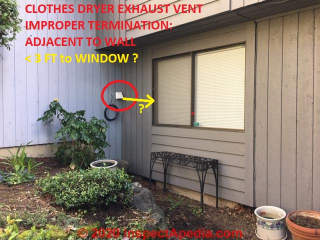
On 2020-04-17 by Lucy
Live in Oregon. Neighbor's electric dryer exhaust located adjacent to common wall and exhaust fumes blow into bottom and upstairs windows and into crawl space. Extremely heavy detergent smell invades home causing health issues (like soaking a mask in concentrated detergent and wearing it 6-10 hours breathing detergent smell).
Never ending lint on windows/screens/siding. Neighbor runs dryer 30-40 hrs weekly - unable to open windows even when outside temperature exceeds 90 degrees. Mold found in cupboard next to adjoining wall (no water pipes in this area).
City inspector stated no code violations? HOA stated it is not a nuisance. Multiple contractors (plumbing, HVAC) have noticed and claimed it violates code.
Could this be a code violation?
[Photo shown above]
On 2020-04-17 - by (mod) - Dryer vent terminates too close to wall & possibly too close to window
Lucy,
Short answer: yes.
Your clothes dryer vent is almost certainly not installed according to the installation instructions from the dryer manufacturer.
Give us the brand and model of your dryer and together we can check what clearance distances are specified by your particular manufacturer.
An example is show in the article above on this page at "Typical Clothes Dryer Exhaust Vent Termination Clearance Distances & Codes"
Technically, if mechanical equipment is not installed according to the manufacturer, it will be thus in violation of local building, mechanical, plumbing, or electrical codes.
However, unfortunately, your local building code compliance inspector is the final legal authority. If she says something is acceptable, then you're not going to be able to get any help from your local authorities.
Try instead offering to your neighbor to pay or share the cost of correcting the installation.
Above on this page we give examples of dryer vent clearance distances in the building codes, excerpted from the IRC (International Residential Code) as adopted by Texas but pertinent in most US states, illustrating the general "code" requirement that equipment must be installed according to the manufacturer's instructions.
Here is an example, from the IRC (International Residential Code) as adopted by Texas but pertinent in most US states, illustrating the general "code" requirement that equipment must be installed according to the manufacturer's instructions:
IRC UMC M1502.2 Duct termination.
Exhaust ducts shall terminate on the outside of the building or shall be in accordance with the dryer manufacturer’s installation instructions.
Exhaust ducts shall terminate not less than 3 feet in any direction from openings into buildings.
Exhaust duct terminations shall be equipped with a backdraft damper.
Screens shall not be installed at the duct termination.
On 2020-04-17 - by Lucy- Neighbor claims dryer is installed in accordance with manufacture instructions.
Thank you for your comments. Do not know model of neighbor's dryer. It is replaced about every 3-4 years.
Neighbor is not cooperative and will not move dryer vent or provide dryer make/model.
Neighbor claims dryer is installed in accordance with manufacture instructions.
On 2020-04-17 - by (mod) -
Neighbor is wrong.
Ib building department won't get involved,
Looks as if we need to focus on protecting your home,
Dryer Temperature vs Clearance Distances in Walls Penetrated by a Clothes Dryer Vent
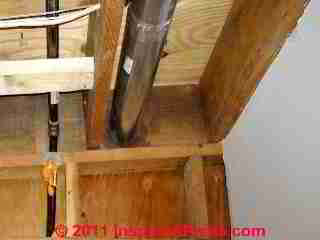 Question: clearances or specifications for walls penetrated by clothes dryer exhaust vent
Question: clearances or specifications for walls penetrated by clothes dryer exhaust vent
Brady Bisel said:
I can’t seem to find anything pertaining to the specs for walls that the dryer exhaust vent is cut and routed to.
By that I mean any specs on the proximity of insulation in wall cavities surrounding dryer exhaust duct and drywall or other wall materials like wood paneling that are combustible and whether or not there needs to be an inch or more space of any of the above mentioned materials?
This question and reply were posted originally
at CLOTHES DRYER VENT INSTALLATION
Photo above-left: the gas fired clothes dryer vent during original construction - before being covered by insulation - in the home whose gas fired clothes dryer measurements are described above
at CLOTHES DRYER TEMPERATURE MEASUREMENTS
An older dryer and dryer exhaust vent in this home were found to be almost completely blocked by lint - shown
at CLOTHES DRYER FIRE HAZARD WARNINGS. Owners had observed clothing coming out of the dryer "extremely hot" and compensated by always running the dryer on its lowest heat setting.
Reply:
Thanks for the great question, Brady. I appreciate it because you point out an area that we should clarify:
Clothes dryer vents are generally installed as zero-clearance, that-is, in direct contact with wall exterior covering (siding), wall framing, insulation in the wall cavity and the interior wall covering.
The reason that direct contact between the dryer exhaust vent and building materials is safe *in normal and proper operating conditions* is that normal dryer operating temperatures in the dryer drum range between 125F and 135F. (GE Corporation, ret. 2017).
The highest temperature claim I've read is 150 degF (perhaps an unsubstantiated opinion).
The air temperature of air exiting the dryer's heater and at the point of entry into the dryer drum or "tumbler" may be hotter, at around 175 F.
The highest temperatures occurring inside the clothes dryer are in the heater element or burner itself where they can reach between 250˚ C and 400˚ C (Marks, 2012) as cited in Bonaccorso (2012) in what I find is one of the most informed studies of clothes dryer temperatures and fire safety.
I have added links to this research in the list of references and research
in CLOTHES DRYER FIRE RESEARCH - you may need to clear your browser cache and wait 24 hours for amendments to this web page to appear in your server.
These temperatures are well below the point of pyrolysis - 200-300 °F (93 - 150°C) - at which a chemical change in combustible materials exposed to relatively low heat but sufficient to lower their combustion point to a dangerous level. I explain this phenomenon
Watch out: there are, however, potential fire hazards associated with clothes dryers that can come from other conditions, discussed
at CLOTHES DRYER SAFETY CHECKLIST
Our photo shows a dryer vent screen including the protective cover provided by the manufacturer. This cover clogs rapidly and is in our opinion unsafe. It was removed and left-off of this dryer vent.
Watch out: there are also clearance distances specified between the wall exhaust point and other features -
see CLOTHES DRYER VENT CLEARANCES & TERMINATION
For example, blowing dryer lint all over the air intake of an air conditioner compressor/condenser unit will lead to higher air conditioning or heat pump operating costs, high temperatures at the unit, and possibly expensive damage to it.
Watch out: to be sure that you use a listed, approved clothes dryer vent termination cover, a self-closing dryer vent.
The exhaust vent cover needs to allow warm moist linty dryer air to blow out of the building without causing a lint blockage in the dryer vent duct or at the vent opening (a fire hazard) while at the same time blocking bird or rodent entry into the dryer duct system (a fire hazard) and avoiding cold air backdrafts into the structure.
Also watch out for improperly installed or sealed clothes dryer vent covers or terminations that permit water leaks into the building -
See CLOTHES DRYER VENT TERMINATION & SCREENS
Also watch out for clothes dryer vents that are in contact with building materials with special combustion hazards such as some foam insulation products.
Clothes Dryer Vent Exhaust Clearance Distance to Water Heater
 What are the risks if the dryer vent blows lint near a water heater or other types of heaters?
What are the risks if the dryer vent blows lint near a water heater or other types of heaters?
Reply: it depends
In our photo at above/left I don't see any risk for the water heater in the routing of this dryer vent duct: the heater is electric so I'm not worried about lint leaks clogging up a gas or oil-fired burner (that would be unsafe), and there is no heat or combustion hazard created between the clothes dryer (on the other side of the partition wall) and its exhaust vs. the electric water heater.
Watch out: notice that gas piping: a gas leak anywhere in the building would of course be very dangerous, risking fire or explosion.
But what about the effects of dryer lint leaks on other nearby mechanical systems. Not shown, but nearby is an oil-fired heating boiler. Lint just loves to accumulate on the oil burner air intake bands - possibly leading to poor heater operation and even in extreme cases, loss of heat.
This dryer is venting properly outside, but before the installation you see at left was completed the contractor added foil tape or sealant where necessary to be sure that there was not lint leak blowing into the utility room.
Reader Comments, Questions & Answers About The Article Above
Below you will find questions and answers previously posted on this page at its page bottom reader comment box.
Reader Q&A - also see RECOMMENDED ARTICLES & FAQs
On 2023-05-07 by InspectApedia Editor - dryer vent that gets the operating parts above ground and that has proven more mouse-resistant
@Jean,
Below is my installation of a dryer vent that gets the operating parts above ground and that has proven more mouse-resistant. This vent, by Lambro, uses dryer exhaust pressure to push an internal plastic sliding cup "up" to allow exhaust to exit (down again!).
When the dryer stops the cup falls to close off the opening - so far it's been good at keeping the mice out and it blows most of its lint out into the yard so that my bad in-laws (you know who you are), who don't spend nearly as much time worrying about lint and blocked dryer exhaust vents as do I, don't have spend more time de-linting the dryer exhaust.
Details about the importance of a clothes dryer exhaust vent door that closes securely are at CLOTHES DRYER VENT TERMINATION & SCREENS
On 2023-05-07 by InspectApedia Editor - "why dryer vents aren't installed up... Hot air rises"
@Jean,
Thanks for a great question.
I certainly agree that we would be foolish to deny basic science: warm air rises.
I think you're asking why the through-wall dryer exhaust vent cover itself points "down".
I'll make up two reasons that the manufacturers will probably say are right:
1. Weather resistance:
it's far easier to make a weatherproof dryer exhaust vent cover that slopes out and down from the wall to shed falling or wind-blown rain than to make one that points "up". Pointing up would risk water leaks into the dryer exhaust and into the building.
2. Cost:
Traditional clothes dryer exhaust vent covers use a simple gravity-operated round aluminum flapper to close the vent opening when the dryer is not running - that's to keep critters out of the dryer venting. For sure I've found mouse infestations in my in-laws' Two Harbors Minnesota home where the dryer exhaust was installed practically touching the ground and where nobody was careful to remove lint that blocked the flapper door, propping it open.
The resulting smell of mouse pee could be noticed indoors near the dryer. Ick. (The mouse invasion of the dryer vent is discussed above on this page at "Dryer Vent Ground Clearance" where you can see a photo of this unfortunate installation.
Actually there I installed an alternative dryer vent that does point "up" - sort-of.
You'll see that the newer modern space age material dryer vents (plastic louvers) also work by gravity, falling "shut" against animal entry when the force of the clothes dryer's exhaust air isn't pushing the vent open.
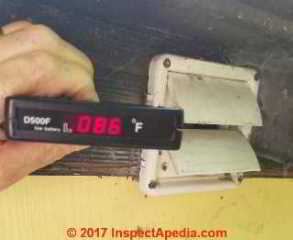
On 2023-05-07 by Jean
Great info, ty. I am wondering why dryer vents aren't installed up... Hot air rises. The brown one on roof could go towards the top of the house so it doesn't blow down.
On 2023-05-07 by InspectApedia Editor - Minimum distance from dryer exhaust and main power meter / power inlet to the building?
@Ernesto,
Thanks for a helpful question: what's the required clearance distance between a clothes dryer exhaust vent and the electric meter or main electrical shutoff switch?
You won't find that answered explicitly in the electrical codes nor appliance installation or dryer exhaust vent codes, but you will want enough distance of separation that you respect the required working clearance distances for electric meters and switches - those are given for meters, switches, and electrical panels discussed at
https://inspectapedia.com/electric/Electrical-Panel-Clearance-Distances.php ELECTRIC PANEL WORKING SPACE
On 2023-05-07 by Ernesto
Minimun distance from dryer exhaust and main power meter / power inlet to the building?
On 2023-04-24 by InspectApedia Publisher
@Michael,
Above on this page we give 9 dryer vent clearance distances. Unfortunately no code or standard can anticipate every possible field installation condition, so some opinion is also needed.
Example: you want to be confident that the dryer exhaust doesn't simply blow moist air and lint up into a roof overhang soffit intake vent and that its lint isn't a nuisance.
Please post a photo showing us the front building front and porch and dryer vent opening location so that we can perhaps see what other clearance distances are important.
Also tell us the gas dryer brand and model so that together we can see what its manufacturer says is required.
Also take a look at inspectapedia.com/Appliances/Clothes-Dryer-Vent-Codes.php CLOTHES DRYER VENT CODES
You'll see that the model building code won't provide a direct answer to your question as you phrased it.
Here is the Florida code: from the 2020 Florida Building Code, Mechanical, 7th Edition
504.4Exhaust installation.
Dryer exhaust ducts for clothes dryers shall terminate on the outside of the building and shall be equipped with a backdraft damper. Screens shall not be installed at the duct termination.
Ducts shall not be connected or installed with sheet metal screws or other fasteners that will obstruct the exhaust flow.
Clothes dryer exhaust ducts shall not be connected to a vent connector, vent or chimney.
Clothes dryer exhaust ducts shall not extend into or through ducts or plenums.
504.4.1Exhaust termination outlet and passageway size.
The passageway of dryer exhaust duct terminals shall be undiminished in size and shall provide an open area of not less than 12.5 square inches (8065 mm2).
On 2023-04-24 by Michael
Florida Requirements for venting a gas dryer vent to the front porch with a roof over hang, no lanai?
On 2023-02-08 by InspectApedia Publisher
@Scott,
If the washer / dryer should be moved up a floor, perhaps you can consider that rather than keep struggling with kids smashing lawnmowers into the dryer vent - a potential safety concern.
On 2023-02-08 by Scott
Thank you for your comments. I had not thought about the issues of snow buildup on the roof, but it could happen.
Reviewing the previous installation, the dryer set in the basement immediately adjacent to the outside wall, so there were 2 90's inside. They did drill a very rough opening through the concrete basement wall. The whole system used 3" pipe, but the termination was so low to the ground that the kids who mowed the grass smashed it all the time. Eventually, a concrete cube was formed around the termination but it was not attached to the foundation wall, so it still got knocked out every now and then.
Other houses in the neighborhood have dryer vents that exit the house through a basement window, sometimes with a goose-neck to bring the stack to a higher level. This added at least two or three extra 90's but most seem to be made with 4" pipe that should better when more bends are needed.
Unfortunately, the entire house is the brick/cinder block construction with the exception of the solid poured foundation and a few dormers that have a "wood" construction (vinyl wood siding).
The washer/dryer unit should be on the main floor simply because of the senior access requirements.
Going the through-the-basement window route would be an almost straight shot from where the duct comes down from the first floor, and several of the 90's could be replaced with 45's in the basement ceiling as well. Either way, it seems this would be within the specified number of bends and straight pipe, even with a goose neck installed which is specified in the installation manual.
A more substantial guard to prevent lawn-mower incidents would also be needed. We have squirrels, racoons and other larger varmints that have caused incidences on may pipe and vents. Sometimes the chew through screens or doors. Sometimes the figure out how to open door flaps. and no matter what is done, I need to insure that the physical vent terminus is robust enough for larger animals, but also able to minimize mice and insect infestations. Two houses within a half-mile have had dryer vent fires due to animals not lint buildup.
Thank you again for your input and I hope this additional information will help you understand this issues I am facing.
On 2023-02-06 by InspectApedia Publisher - start with the installation specs in the dryer manufacturer's guide
@Scott,
You have my sympathy - I agree that fear of litigation muzzles people who might otherwise be helpful.
In my opinion, because there are venting limits of length, height, number of elbows or bends, etc., your best bet is to start with the installation specs in the dryer manufacturer's guide, then call their technical support number with any remaining questions.
By the way, a rooftop vent can be snow blocked too, and can be a devil to clean of lint.
Are you sure you can't vent out through a sidewall on a shorter route, ending in accessible location, and provide protection from snow-blockage there?
On 2023-02-06 by Scott
Dryer Vent -- Go up or down?
I am working on a one and a half story house that will have a combination washer/dryer installed on the main floor. The house is being remodeled for better senior access (but will not be in full ADA compliance due to budget limits.)
There is an area where the unit can be placed and has the proper clearances to the sides, back, door openings, etc. What I need is some advice on if running the dryer vent up and through the attic and basically straight out the roof (with appropriate vent cap) would be okay. I can also run the vent pipe through the first floor (wall or floor) and down through the un-finished basement and out the side wall. The dryer will be electric in this unit.
The house is of cinder block with very hard brick covering outside and 3/4 inch wood furing strips with non-combustible plaster and backing.
There are several reason I do not like the through the wall approach --
1. Because of snow drifts the dryer vent could be blocked by snow on bad days in the winter.
2. The dryer vent would be under a bedroom window (unless vent is taken somewhere else.
3. The natural "city" gas line enters the building about 8 feet away, but this is around an outside corner.
4. There also is the issue of having to have someone bore a hole through the brick/block area or through an 8 inch concrete wall -- something that is estimated to cost about 300 to 500 dollars.
On the positive side (?) the dryer vent will mostly be in open air except where it runs through from the dryer (on the first floor) and the basement. Interior wall construction is standard 2x4 with sheet rock and/or plaster.
Issues with the roof route that I see are there would be about 5 feet inside the first-floor wall and there would be close contact also where the vent exits the roof, along with increased chances of water leakage. Larger rodents (squirels?) have chewed their way through thin roof vents in the past, so an extra heavy vent system would be needed at the roof to minimize damage they might try to make.
My question is would the roof run with almost 20 feet of vertical vent collect lint that will loose velocity as it leaves the dryer -- lint that could fall back into the line at or near the actual dryer. If this is not an issue, I would prefer to go the up to the roof route.
Our local building inspectors will no longer make recommendations -- only critique things after they are complete. Their attitude it "do whatever you feel you should, and if we don't agree with what you did, we will make you do it again. The same standard is used with contractors and homeowners.
They won't even accept a stamped drawing from an engineer or architect any more! This is supposedly being done to limit the city's liability if something "hidden" is done wrong or if an inspector is unaware of or simply refuses to review issues that come up at the front of the job. (Inspectors now work on a per-hour basis paid to the city instead of a per inspection cost regardless of how much or how little they actually do.)
On 2022-11-10 by InspectApedia (Editor) - document carefully what building codes require for a dryer vent clearances
@Brian,
I can't answer the question about forcing property managers to do anything, that's a question you would need to take to an attorney. However it might help your case to document carefully what building codes require for a dryer vent clearances and to point out to the property managers that they're tired vents are not in compliance.
On 2022-11-10 by Brian
Hello. I live in a downstairs apartment and my bedroom and bathroom are right next to the clothes dryer exhaust vent. The exhaust vent is closer than 3 feet to my bathroom window and bedroom sliding glass door. The vent is also closer than 1 foot off of the ground and right next to a corner wall.
The exhaust fumes blow lint and dust right into my patio and bedroom living space. I have to shut my window and door every time someone uses the laundry facilities. It is not fair that I am the only tenant who has to deal with this issue. I have severe allergies to dust mites and mold which are overwhelming with this problem.
I called my property management and they told me that there is nothing they will do if everything is functioning properly. I voiced my concerns about the health problems associated with this issue and they did not care at all. They told me they would charge me $110 to have a plumber come and look at it.
Is there anything I can do to force the property management company to fix this huge problem?
On 2022-11-10 by InspectApedia (Editor)
@Angel,
https://inspectapedia.com/Appliances/Clothes_Dryer_Vent_Clearances.php#GasMeter
In the article above on this page has the data that you need
On 2022-11-09 by Angel
Clothes dryer vent in relation to the gas lines and the Rinnai RSC160en water heater. I am repositioning the dryer vent and need to know how far away I need to be from the main gas line regulator and how far away the natural gas exterior tankless water heater need to be.
On 2022-10-21 by InspectApedia (Editor) (mod) - Why does the dryer vent need to be 3 ft from door or window?
@Sue,
You're avoiding sending humid, possibly lint-dusty-air back into the building.
On 2022-10-21 by Sue
Why does the dryer vent need to be 3 ft from door or window?
On 2022-07-20 by InspectApedia-911 (mod) - sand blocked dryer vent increases energy costs, prevents the dryer from operating properly, and in some cases can be a serious fire hazard at the building
@Bridget ODonnell,
It would certainly be helpful if you could post a photo of the dryer of concern and even better, a photo of the vent when it has become sand covered .
You can point out to the building owner that blocked dryer vent increases energy costs, prevents the dryer from operating properly, and in some cases can be a serious fire hazard at the building.
On 2022-07-20 by Bridget ODonnell
Hello thanks for such a detailed guide this is wonderful. I could use some advice though. I look after a beach house and every summer the wind picks up the sand and pushes it to the side of house where the dryer vent is located. It keeps building up and has completly covered the dryer vent.
This house was built about 5 years ago and is beautiful but this is a vacation rental. . The dryer needs to be re vented but the home owner has. Not fixed problem so I have to go dig it out but then just fills back up how can I convince homeowner to fix this issue
On 2022-06-12 by InspectApedia-911 (mod) - check installation manual for allowed number of bends in venting scheme
@ERIC WOODALL,
We don't know what the total number of elbows will be in that installation.
You're allowed to use elbows in the vent line and like you I would
prefer making them is gradual as possible using 45s instead of 90s.
You'll see in the installation instructions that bends in the vent line are equivalent to adding length - you're limited in the number of them. Compare your entire installation scheme against what the manual tells you is permitted for your particular dryer exhaust vent installation.
On 2022-06-11 by ERIC WOODALL
I removed a plumbing vent where dryer vent is installed because it can be tied in to another vent that services only a downstairs sink drain that is no longer used. It was easier than cutting another hole in the roof. Just a little offset of straight up as you can see in the photo. Do the turns in pipe look acceptable?
As for venting, there is a ridge vent at top of roof, and large gable vents on each side of house in addition to soffit vents.
Please pay no attention to the wiring around vent. It is not connected, and will be re-routed.
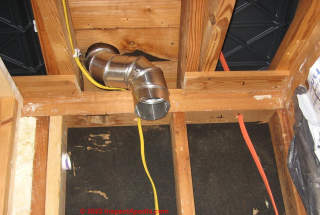
On 2022-06-11 by InspectApedia-911 (mod) - placement of DryerJack 477 vent on the roof
@ERIC WOODALL,
Thanks for the question on location of the DryerJack 477 - (for other readers, this is a rooftop termination for a clothes dryer exhaust vent).
I note that the installation instructions for this vent termination do not mention clearance distances from anything.
While of course there can always be some on-site condition that is important and that we can not know or see from the very limited information in a posted question and photo, still, warm air rises: one wouldn't expect moist air to roll downwards from a rooftop-mounted exhaust vent to fall off of the roof and then scroll back up into the attic through a soffit or eaves vent.
I do note that your roof venting may well be inadequate - with intermittent spot vents along the soffits and - I'm not sure what's at the ridge.
Keeping the exhaust vent as short and straight as possible is smart.
Below: a close-up of the Dryer-Jack clothes dryer rooftop exhaust vent termination cap, for which a copy of the instructions is available from the company and also at
- DRYER JACK CLOTHES DRYER EXHAUST VENT CAP INSTALLATION INSTRUCTIONS [PDF] In-O-Vate Technologies, Inc., 250 S. Central Blvd. Suite 20, Jupiter, FL 33458 USA, Tel: 561-743-8696 Web: www.DryerJack.com
On 2022-06-11 by ERIC WOODALL
Hi! I am wondering if placement of DryerJack 477 vent on the roof is okay as far as proximity to soffit vent underneath the eave. I am wondering if hot exhaust will cloud up under the eave in the winter and get sucked up into the soffit. I thought about mounting it higher up, but felt like the exhaust could drift down no matter how high I mounted it. And I was trying to make the vent as straight as possible for routing cleaning.
This is a second-floor stacked washer and dryer. Vent pipe going up to dryer vent is 26 ga. galvanized steel.
On 2022-06-04 by InspectApedia (mod) - condensation and smells in my clothes dryer
@Susan,
Clothes dryer exhaust vents should be directed to the building exterior. If yours is into an enclosed space, you may need to investigate that area for excessive moisture, condensation, mold, etc.
Please take a look at this article
CLOTHES DRYER EXHAUST VENT INSTALLATION
where we describe clothes dryer exhaust vent installation codes & specifications.
Adding a couple of additional points, if your dryer vent is routed over too great a distance through your home it may exceeding the dryer's venting capacity.
So you need to look at the installation manual for your particular dryer brand and model, and compare the allowed vent distances with what you're actually doing.
About the dog hair problem I don't see how a dryer vent routing would be responsible for high levels of dog hair and dust throughout the home.
More likely, the source is the three dogs.
Please let us know what you find and if you have further questions.
On 2022-06-04 by Susan
Hi, my laundry room is in the interior of my home so the vent goes to the 2 nd floor, through the attic and terminates inside the eaves.
My dryer has been getting condensation inside and the clothes smell funny and sometimes I need to run an additional cycle. My dryer vent is cleaned after every use.
I have 3 dogs and it seems excessive hair and dust everywhere. I’m wired about the HVAC blowing dryer lint into my home! Is this possible and what to do?
On 2022-03-06 by Inspectapedia Com Moderator
@Matt,
In the article above please see the live link for
DRYER VENT TERMINATION DISTANCE to AIR CONDITIONER / HEAT PUMP / AIR INTAKE
you'll see that the principal concern is with lint clogging the condenser unit air intake surfaces.
On 2022-03-06 by Matt
How far away from an air conditioning condensing unit is heal I will distance for a dryer vent are we allowed to put dryer vent above air conditioning condenser unit or how far away does it have to be
On 2022-01-11 by Inspectapedia Com Moderator - crawl space access door distance from dryer vent
@FRANK REXFORD,
From a normal building opening like a window or door you'd use 3 ft.
From a crawlspace entry, normally closed, open rarely, IMO that distance needn't apply.
see
DRYER VENT TERMINATION DISTANCE to DOORS or WINDOWS
On 2022-01-09 by FRANK REXFORD
How close to. Crawlspace access door can a dryer vent be located?
On 2022-01-06 by Inspectapedia Com Moderator - neighbor's exhaust vent is too close to my house
@Alison,
If the dryer vent opening is less than 3 ft from a window, it may violate Toronto code. In such case you might offer to share the expense of relocating or extending the exhaust opening.
On 2022-01-06 by Alison
My next door neighbour installed a gas laundry dryer on her second floor and the vent pours out exhaust directly towards my house. The houses are 3 feet apart..2 feet is my property and 1 foot is hers. During cold the exhaust vapor hits my side brick wall and it is wet.
Also my bathroom windows are very close to the vent. I have windows on my side as well. I live in the city of Toronto. What can I do.
On 2021-06-30 by inspectapedia.com.moderator - foundation vent variables
@Cheech,
Physically , yes but there are quite a few remaining questions:
- is the termination sufficiently high above ground level for your climate and snow fall?
- is moisture blowing back up under the building siding?
- is the vent duct properly-routed so as not to accumulate water?
- is the use of the foundation vent subverting a crawlspace venting system?
Search InspectApedia.com for CRAWLSPACE DRYOUT or for CRAWLSPACE VENTILATION to see more details.
On 2021-06-30 by Cheech
Can a dryer vent be terminated outside through a foundation vent?
On 2021-05-01 by (mod) - Safe Distance Between Dryer Exhaust and Gas Heater Combustion Air Intake & Exhaust
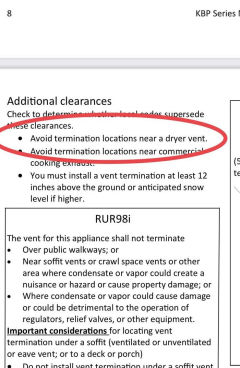 @MikeC,
@MikeC,
So they may have run into the very trouble that we've been speculating about. I can see two potential hazards:
1. Likely: Lint damage to heater: lint from the dryer is sucked into the combustion air intake for the Rinnai water heater, causing a malfunction, possibly even affecting safety
2. Less likely but possible: CO hazard: when the dryer is NOT running, and in particular if the dryer vent closure flap is not working - as is common due to lint clogging - there could be dangerous backdrafting of combustion gases from the heater's exhaust, entering the house through the dryer vent.
Unfortunately we don't know what the company considers "close to" - probably lawyerspeak for "keep us out of trouble by keeping it vague"
Earlier I suggested investigating extending the dryer exhaust further away;
If you decide to call Rinnai to get details do let us know as that will help other readers.
Watch out: in addition to safety and operating concerns arising from having a clothes dryer exhaust vent too close to both combustion air intake and heater exhaust for your gas heater, there are also required clearance distances between the heater vent and nearby projecting building walls.
That wall to the right in your photo [shown below] may also be too close; that's another clearance to check with the Rinnai's installation manual.
On 2021-05-01 by MikeC - Rinnai manual does say “avoid” termination near dryer vents
thanks for all the feedback. The Rinnai manual does say “avoid” termination near dryer vents but that’s it. Sounds like I likely don’t have any direct code violations since dryer to AC and dryer to combustion air intake don’t have defined minimums, but in practice the dryer lint can affect the water heater’s performance as lint burns onto the burners.
Since dryer to AC condenser isn’t defined, I think moving the dryer vent to the left would be cleanest option.
Lint affecting AC unit is likely much less likely given how wind and air flow is in this corner of the house and cleaning any lint off the condenser would be simple compared to burner replacement in the tankless.
One other idea I had was to extend the air intake 2 or so feet “away” from the house to distance it from the dryer but that wouldn’t look clean and I’m not sure if that is a different violation.
On 2021-04-30 - by (mod) -
@MikeC, thanks that's important feedback.
Did you get anything in Rinnai about a concern for dryer lint in the Rinnai's tankless water heater air intake?
Have you reviewed all of the distance involved in your dryer vent to see if you could extend it upwards and sideways - perhaps indoors or outside - without exceeding the total allowable (and safely) run length?
Modern dryers do a better job at sensing unsafe temperature and shutting down, but I still wouldn't want to risk an add-on lint filter.
You'll notice that Rinnai gives clearances to combustion air INLETS of other appliances
Clearance to nonmechanical air supply inlet to building or the combustion air inlet to any other appliance (12 inches U.S., 36 inches Canada)
Clearance to a mechanical air supply inlet (Canada 6-feet, U.S. 3 feet (91 cm) above if within 10 feet (3 m) horizontally)
Nothing in those clearances addresses clearance to another building mechanical air OUTLET such as a dryer vent.
The Rinnai tankless water heater is taking its combustion air from outdoors - just inches from its very own exhaust, though the air intake and exhaust outlet are not only to be separated as per the installation manual, but also use elbows or bends to face in different directions - as in your photo. Pulling combustion air from outdoors helps keep the Rinnai water heater from fighting with the clothes dryer for combustion air.
But the dryer exhaust vent, though more-distant from the Rinnai air intake than the Rinnai's own exhaust, produces moisture and lint.
So what remains is to ask the company directly if they're worried about sucking dryer exhaust moisture or lint into the air intake of your Rinnai tankless water heater.
And of course for your installation you're assuming that the clothes dryer's own air INTAKE is coming from indoor building air and spaces and that it's not air starved. Anywhere that a dryer and other gas fueled heating equipment are fighting over combustion air there's a risk of fatal carbon monoxide poisoning - hence you also want working CO detectors properly located in your building.
On 2021-04-30 - by (mod) -
@MikeC, thanks; that's pretty much the same clearances we've found in other gas appliance direct vent sources
GAS APPLIANCE / HEATER DIRECT VENT CLEARANCES
- I'll excerpt p. 7 here - [Click to enlarge any image]

On 2021-04-30 4 by MikeC - We’ve definitely had issues with lint getting pulled into the Rinnai tankless gas water heater combustion intake
We’ve definitely had issues with lint getting pulled into the combustion intake.
Tankless started throwing codes and had to replace the burners at the tune of $1000 in labor. I’d love to move the dryer vent to the left away from the intake but it will move closer to the ac condensing unit and from what I read there could be code saying that the dryer vent and AC unit must be 6 feet apart? They are only 2.9 feet apart as it is now. I feel like I’m in a jam trying to
It’s a Rinnai Rur98i
Install manual page 7 has vent locations
On 2021-04-28 - by (mod) -
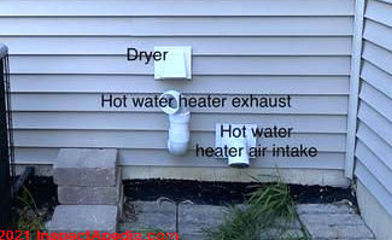 @MikeC,
@MikeC,
GAS APPLIANCE DIRECT VENT CLEARANCES at https://inspectapedia.com/chimneys/Gas-Heater-Direct-Vent-Clearances.php
gives code and typical clearance distances from a condensing boiler, furnace, or water heater exhaust to other building features like windows and combustion air intakes.
As the dryer vent is an exhaust, I think a concern may be sucking lint into the heating equipment's combustion system.
Let's get past theory to specifics by naming your tankless water heater brand and model; then we can look at its installation and operation manual where the manufacturer's required clearances around its combustion air intake and exhaust, specific to that product, will be given.
Watch out: in addition to safety and operating concerns arising from having a clothes dryer exhaust vent too close to both combustion air intake and heater exhaust for your gas heater, there are also required clearance distances between the heater vent and nearby projecting building walls. That wall to the right in your photo may also be too close; that's another clearance to check with the Rinnai's installation manual.
On 2021-04-27 by MikeC
We have a direct venting tankless water heater that was installed a few years ago. It’s air intake and exhaust are fairly close to the dryer exhaust. I’m going to be getting permits pulled for an unrelated job soon and I’m wondering if the installer violated any codes with this placement?
It’s > 12 inches from grade and > 12 inches from inside corner but I can’t find code details on direct venting gas appliance distances from dryer vents (if any such requirements exist)
[Photo above]
On 2021-04-23 - by (mod) -
@Eric,
Dryer exhaust vents can certainly be routed up and out - but I don't understand your question beyond that general remark, to which I add
just check the total run length, number of elbows etc to be sure you stay within the dryer manufacturer's installation guidelines.
On 2021-04-23 by Eric
Can i install dryer wall vent on exterior wall 8 ft above ground To avoid running the line another 8 ft down on the interior wall before exiting?
On 2021-01-11 - by (mod) -
Margaret:
I can't give an un-arguable answer to the limits of contractor liability and even less for code officials. Let's focus first on safety and second on function.
That means: vent the dryer to outside properly, and in the course of that installation, inspect the wall cavity to assure that the dryer moisture hasn't caused a hidden mold reservoir or that dryer moisture hasn't wet and corroded nearby electrical devices.
My OPINION is that only a lazy idiot vents a dryer just into a wall cavity.
On 2021-01-11 by Margaret
I had my basement renovated in 2006 and put in a laundry room. Since there was underpinning involved as I was digging as I was digging the foundation about two feet down and I was getting funding from the Canada Housing Corporation in forgivable loans, I had a structural engineer, an architect, a general contractor and a Toronto City building inspector involved.
I just learned that my dryer was not venting properly and to code. My dryer has been venting into my wall. I am getting some insurance construction work done and the general contractor had to reattach the dryer and discovered that there was no tube/duct work to attach the interior coil dryer vent.
I understand that the Toronto City codes concerning dryer vent systems changed in 2006. My laundry room renovation was completed in 2007. Apparently for years my dryer has not been venting safely. My current contractors have quoted me $770.00 to cut the drywall, install the proper tube, hook up the dryer vent, drywall and paint the wall.
My question is, how long are contractors, city building inspectors and other professionals involved in a major home construction liable for their work? What if the work they did was not done to code and could not be seen because it was covered with drywall? Should I contact the original contractor and ask them to rectify the matter? Has it been too long for the original contractors to be responsible for properly venting my dryer? Is the Building Inspector responsible?
Any comments or suggestions about going forward would be greatly appreciated.
Thank you.
On 2020-11-08 by Strong Builders
Thanks Geri. Very helpful
On 2020-10-29 - by (mod) -
Geri
Venting a dryer "UP" can be safe provided that your total vent run, number of bends or elbows, vent size and material and termination details all meet the dryer manufacturer's specs.
Top priority: be sure you have properly installed, located, tested, working CO detectors and fire/smoke detectors in the building.
You might want to have all of your gas-fueled appliances and equipment checked for proper operation and also their environment checked to be sure there is adequate combustion air.
Keep in mind that because a dryer is exhausting air from the building, in a tight space it could create a combustion air shortage for some gas burners.
On 2020-10-29 by Geri
Is it safe to have a gas dryer vent to run 10 ft straight up the basement concrete wall to be vented outside ? I bought a Brand New gas dryer 5 months ago because we had a C O leak and fire department run late one evening. Now tonight with my Brand new gas dryer we just experienced another C O build up.
On 2020-09-14 by lisa
Thanks. Appreciate your feedback.
On 2020-09-14 - by (mod) -
I can't say for sure, Lisa; your local building inspector is the final legal authority on code interpretation.
Arm yourself with the manufacturer's installation instructions and give a call and ask for help. The inspector will be on your side.
On 2020-09-14 by lisa
- I can easily access where the dryer exhaust exits the house and would also be able to access the terminal at the edge of the deck so I could clean and inspect from both sides. Would a town building inspector have an issue with this set up?
On 2020-09-14 - by (mod) -
Lisa
We've had other readers describe extended outdoor routings of dryer vents; it's done, but uncommon. My worry is inadequate insulation, condensation, freezing, blockage.
You'll want to be able to easily access the vent extension for both cleaning and to check that it's not blocked by frost or ice.
On 2020-09-14 by lisa
the comment below from Anonymous is a reply from me! sorry for the confusion.
On 2020-09-14 by Anonymous
- The present location of the vent is where I plan to build a deck. The wall where the existing vent is located is only one story.
The wall has a single door, sliding glass door and a window which makes relocation with a 3 foot perimeter from these items impossible. I cannot move the location of the dryer and running internal ductwork to an alternate wall would be a huge endeavor.
Hence my thought to extend the ductwork externally. Even with the extension I would not exceed the maximum duct length.
On 2020-09-14 - by (mod) -
Lisa
You could build such an insulated vent extension though I'm unclear why, and I worry about exceeding manufacturer's recommended maximum duct length or reduced dryer effectiveness or frozen condensate in very cold weather - a blocked duct would, as I see you realize - be unsafe.
On 2020-09-14 by lisa
I live in NY (so cold and snow are an issue). Assuming I am well within the required footage for venting, can I extend a electric dryer vent exhaust out 8ft from the house under a deck with it terminating at the deck's outer edge
(i would insulate the outside "ducts", install at an angle down and away from the house for moisture to drain and have the end of the duct at the end of the deck so exhaust is expelled away from the deck, not under it)?
On 2020-09-14 - by (mod) -
You are correct that if the dryer exhaust vent opening is in a location where it could be blocked by snowfall at needs to be protected or sufficiently high above ground. It's also my experience that those louvered indoor dryer vent openings are prone to clogging with lint which can lead to a higher so you need to be sure to keep the vent and the exhaust opening clean.
On 2020-09-14 by LS
We just had a licensed company install a new dryer vent for us. Our old one goes far up out the roof which made cleaning difficult and we were concerned about safety. The team recommended putting the vent directly behind the dryer.
The vent goes out onto our front porch. They installed a louvered door. As they were installing I asked about the usual recommended 12 inch clearance from the ground as the new vent is about half that from the top step of the porch where it is located (it isn’t too far from the edge of the step where it would be a foot from
The actual ground). The guy said that One foot requirement would apply for a hood that directs air down but since they installed the louvered door with flaps we were ok to have it closer to the ground. Is this true?
On 2020-09-06 - by (mod) -
Yes, we're looking at a lint clog problem at least
On 2020-09-06 by Debbie
My dryer vent is at the most 6 inches from my AC. I just realized this today. Is this a problem? Thinking when both run at the same time lint from dryer will accumulate on AC and AC is pushing air from AC and air back into my dryer vent. Thank you, Debbie
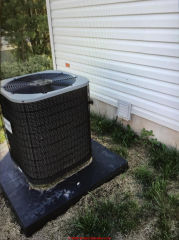
On 2020-05-22 - by (mod) -
David
I would treat the crawl space vent to dryer vent distance the same as for distance between dryer vent and any other building ventilation opening such as windows and doors
https://inspectapedia.com/Appliances/Clothes_Dryer_Vent_Clearances.php#WindowWall
On 2020-05-21 by David
How far must the outside wall mounted dryer vent be from a crawl space exhaust vent?
On 2020-04-20 - by (mod) -
Lucy
Please see your original question and our discussion now found above on this page at
DRYER VENT TERMINATION DISTANCE to DOORS or WINDOWS
Keep me posted and ask further questions as needed.
Thank you for the discussion.
On 2019-12-13 - by (mod) - dryer vent 2" from ground
Yes your dryer vent is too close to the ground - and I agree risks snow blockage.
The minimum recommended height above ground is 12" or in my opinion a height above the highest anticipated snow cover that may fall in the area of the vent. (That's what you'll typically see in manufacturer's installation instructions for a clothes dryer vent termination or cover.)
On 2019-12-13 by Dino
What is the building code for ground clearance of a dryer vent in Twin Falls, Idaho? Mine is only 1 1/2 - 2 " and seems wrong due to snow that we get. Thanks
On 2019-09-27 - by (mod) - exhaust vent from the dryer out under a deck
That should be okay provided your meeting the other clearances that are discussed in the article above.
I'm guessing that the location under the deck is assuring you that if you live in the snow climate that the de k assures that there's no concern with the venting blocked by snow.
On 2019-09-26 by Paul
Can an exhaust vent from the dryer come out under a deck with a 20 inch ground clearance?
On 2019-09-11 - by (mod) - 0-foot dryer vent Clearance
There is a 10-foot dryer vent Clearance discussed in the article above. It's not specific to Windows however.
Typically a 3 foot distance is required from windows to a dryer vent.
Keep in mind that your local Building Code Compliance inspector is the final legal Authority on this question
On 2019-09-10 by pamela
The odors from my neighbors dryer vents into my windows, Also soap smells. I live in a 17 story building in NYC. DOB said the vent needs to be 10' from living spaces (my windows). These are not.
But I don't see that written anywhere and I'm trying to get that addressed. Neighbor will not allow an inspection, so gathering info to write and want to be accurate.
Can you advise?
Thanks!
On 2019-05-16 - by (mod) -
Hugh
I'm not sure what problem we're solving here. But you may be able to extend the vent exhaust termination past the wall if there's some good reason to do so - just be sure it's tipped down away from the building so as to avoid a condensate back-drain problem and that it's protected as appropriate.
On 2019-05-10 by hugh
can i put the vent pipe 4 ft out from the wall if i insulate & support outside conditions ?
...
Continue reading at CLOTHES DRYER VENT CODES or select a topic from the closely-related articles below, or see the complete ARTICLE INDEX.
Or see CLOTHES DRYER VENT CLEARANCE FAQs - Q & A posted originally at this article.
Or see these
Recommended Articles
- CLOTHES DRYER FIRE HAZARD WARNINGS
- CLOTHES DRYER VENTING - home
- CLOTHES DRYER VENT BOOSTER FANS
- CLOTHES DRYER VENT CLEARANCES & TERMINATION
- CLOTHES DRYER VENT CODES
- CLOTHES DRYER VENT ENERGY SAVINGS
- CLOTHES DRYER VENT INSTALLATION
- CLOTHES DRYER VENT TERMINATION & SCREENS
- DRYER EXHAUST VENT DUCT MATERIAL & SIZE
- DRYER EXHAUST VENT HOOD TYPES
- DRYER EXHAUST VENT INSTALLATION & ELBOWS
- DRYER EXHAUST VENT ROUTING OPTIONS
- DRYER EXHAUST VENT MISTAKES
- DRYER EXHAUST VENTED INTO ATTIC
- DRYER EXHAUST VENTED THROUGH ROOF
- DRYER EXAUST VENTED INTO CRAWL
- DRYER INSTALLATION & OPERATION MANUALS
Suggested citation for this web page
CLOTHES DRYER VENT CLEARANCES & TERMINATION at InspectApedia.com - online encyclopedia of building & environmental inspection, testing, diagnosis, repair, & problem prevention advice.
Or see this
INDEX to RELATED ARTICLES: ARTICLE INDEX to APPLIANCE REPAIR
Or use the SEARCH BOX found below to Ask a Question or Search InspectApedia
Ask a Question or Search InspectApedia
Questions & Answers on bathroom vent fan and fan ducting installation procedures, codes, standards.
Try the search box just below, or if you prefer, post a question or comment in the Comments box below and we will respond promptly.
Search the InspectApedia website
Note: appearance of your Comment below may be delayed: if your comment contains an image, photograph, web link, or text that looks to the software as if it might be a web link, your posting will appear after it has been approved by a moderator. Apologies for the delay.
Only one image can be added per comment but you can post as many comments, and therefore images, as you like.
You will not receive a notification when a response to your question has been posted.
Please bookmark this page to make it easy for you to check back for our response.
Our Comment Box is provided by Countable Web Productions countable.ca
Citations & References
In addition to any citations in the article above, a full list is available on request.
- [1] Heartland 21000 Dryer Vent Enclosure
- [1] Lambro Industries 289W Dryer Vent Enclosure
- [2] "Overheated Clothes Dryers Can Cause Fires, CPSC Document # 5022 Updated June 2003", U.S. Consumer Product Safety Commission, www.cpsc.gov., websearch 11/25/2011, original source: cpsc.gov/cpscpub/pubs/5022.html
- [3] "Electric and Gas Clothes Dryers, Staff Evaluation and Contractor Report", US CPSC Memorandum, 25 Feb 2000
- [4]"Report on Electric and Gas Clothes Dryers", U.S. CPSC Memorandum, 25 Feb 1999, the Clothes Dryer Project, March 1999
- [5] UL Standard 2158, voluntary standard for electric clothes dryers
- [6] ANSI Z21.5 1 (CGA 7.1) voluntary safety standard for gas powered clothes dryers
- "Bathroom Vent Fan Beats Open Window", James Dulley, Poughkeepsie Journal, 11/4/1987 p. 12D.
- In addition to citations & references found in this article, see the research citations given at the end of the related articles found at our suggested
CONTINUE READING or RECOMMENDED ARTICLES.
- Carson, Dunlop & Associates Ltd., 120 Carlton Street Suite 407, Toronto ON M5A 4K2. Tel: (416) 964-9415 1-800-268-7070 Email: info@carsondunlop.com. Alan Carson is a past president of ASHI, the American Society of Home Inspectors.
Thanks to Alan Carson and Bob Dunlop, for permission for InspectAPedia to use text excerpts from The HOME REFERENCE BOOK - the Encyclopedia of Homes and to use illustrations from The ILLUSTRATED HOME .
Carson Dunlop Associates provides extensive home inspection education and report writing material. In gratitude we provide links to tsome Carson Dunlop Associates products and services.


